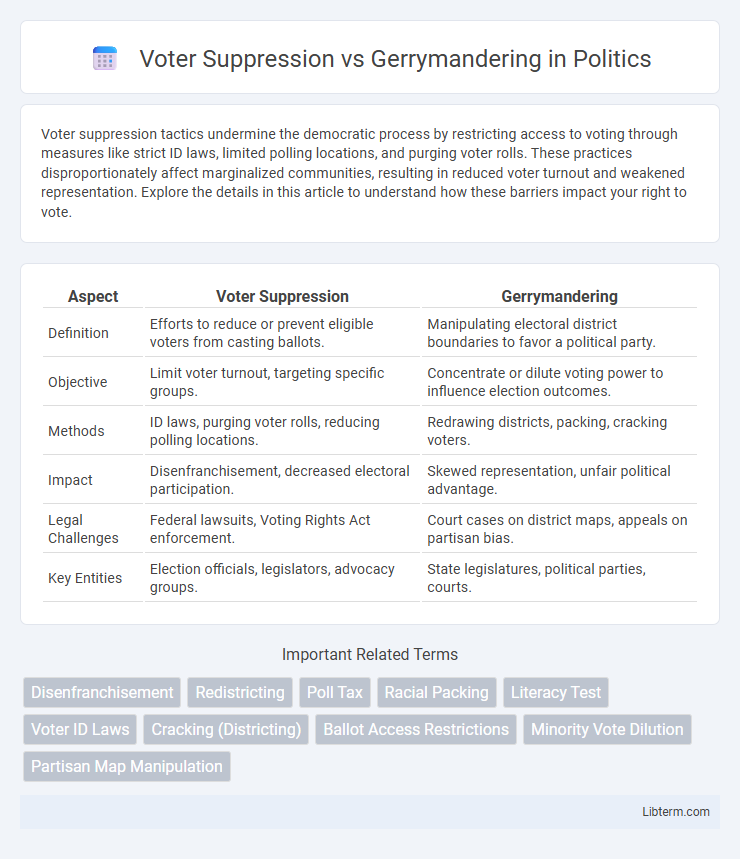Voter suppression tactics undermine the democratic process by restricting access to voting through measures like strict ID laws, limited polling locations, and purging voter rolls. These practices disproportionately affect marginalized communities, resulting in reduced voter turnout and weakened representation. Explore the details in this article to understand how these barriers impact your right to vote.
Table of Comparison
| Aspect | Voter Suppression | Gerrymandering |
|---|---|---|
| Definition | Efforts to reduce or prevent eligible voters from casting ballots. | Manipulating electoral district boundaries to favor a political party. |
| Objective | Limit voter turnout, targeting specific groups. | Concentrate or dilute voting power to influence election outcomes. |
| Methods | ID laws, purging voter rolls, reducing polling locations. | Redrawing districts, packing, cracking voters. |
| Impact | Disenfranchisement, decreased electoral participation. | Skewed representation, unfair political advantage. |
| Legal Challenges | Federal lawsuits, Voting Rights Act enforcement. | Court cases on district maps, appeals on partisan bias. |
| Key Entities | Election officials, legislators, advocacy groups. | State legislatures, political parties, courts. |
Introduction to Voter Suppression and Gerrymandering
Voter suppression encompasses tactics and laws such as strict voter ID requirements, purging voter rolls, and limiting early voting designed to reduce voter turnout and disproportionately affect marginalized groups. Gerrymandering involves manipulating electoral district boundaries to favor a particular political party, often diluting the voting power of opposition supporters and impacting election outcomes. Both practices undermine democratic principles by restricting fair representation and skewing political power distribution.
Defining Voter Suppression
Voter suppression consists of tactics and laws designed to restrict or limit the ability of specific groups, particularly minorities and disadvantaged populations, to vote in elections. These methods include strict voter ID laws, purging of voter rolls, reduction of polling places, and limiting early voting periods. While gerrymandering manipulates electoral district boundaries to influence election outcomes, voter suppression directly undermines voter participation and accessibility.
Understanding Gerrymandering
Gerrymandering involves manipulating electoral district boundaries to favor a particular political party or group, often diluting the voting power of opposition supporters. This tactic undermines fair representation by concentrating or dispersing voters in strategic ways to influence election outcomes. Understanding gerrymandering is essential to recognizing how redistricting can impact democracy and voter influence beyond overt voter suppression efforts.
Key Differences Between Voter Suppression and Gerrymandering
Voter suppression involves tactics that directly restrict or discourage eligible voters from casting their ballots, such as strict ID laws, limited polling locations, and purging voter rolls. Gerrymandering manipulates electoral district boundaries to favor a particular political party or group, often diluting the voting power of certain populations. While voter suppression targets voter access and participation, gerrymandering focuses on the spatial configuration of districts to influence election outcomes.
Historical Context and Origins
Voter suppression and gerrymandering both have deep historical roots in undermining electoral fairness in the United States, with voter suppression dating back to post-Reconstruction laws designed to disenfranchise African American voters through literacy tests, poll taxes, and intimidation. Gerrymandering originated in the early 19th century, notably named after Governor Elbridge Gerry of Massachusetts in 1812, when electoral district boundaries were manipulated to favor political parties. These tactics persist as mechanisms to influence political power by restricting or diluting the voting strength of specific groups.
Modern Tactics and Techniques
Modern voter suppression tactics include strict voter ID laws, purging voter rolls, reducing polling places in minority areas, and spreading misinformation to discourage turnout. Gerrymandering techniques involve using advanced data analytics and software to redraw electoral district boundaries that maximize partisan advantage by packing or cracking opposition voters. Both strategies undermine democratic representation by strategically limiting the voting power of targeted populations through legal and technological means.
Legal Responses and Court Rulings
Legal responses to voter suppression and gerrymandering have evolved through numerous court rulings aimed at protecting electoral fairness. Landmark cases such as Shelby County v. Holder weakened key provisions of the Voting Rights Act, impacting voter suppression oversight, while Rucho v. Common Cause ruled that federal courts cannot adjudicate partisan gerrymandering claims. State-level legislation and judicial interventions continue to address unfair district maps and voter access barriers, emphasizing the ongoing judicial role in safeguarding democratic processes.
Effects on Elections and Voter Turnout
Voter suppression tactics such as strict ID laws and limited polling locations reduce voter turnout by creating barriers that disproportionately affect minority and low-income populations. Gerrymandering manipulates electoral district boundaries to favor specific parties, diluting the voting power of opposition supporters and skewing election results. Both practices undermine democratic representation by decreasing electoral competitiveness and disenfranchising eligible voters.
Ongoing Debates and Controversies
Voter suppression and gerrymandering remain central issues in American electoral politics, sparking ongoing debates about fairness and democratic representation. Voter suppression tactics such as strict ID laws and purging voter rolls disproportionately impact minority communities, raising concerns about disenfranchisement and election integrity. Gerrymandering manipulates district boundaries to favor one party, undermining electoral competitiveness and prompting courts to grapple with defining legal standards for partisan maps.
Solutions and Future Outlook
Addressing voter suppression requires robust federal voting rights legislation and the expansion of access to mail-in and early voting to ensure equitable participation. Gerrymandering can be mitigated through independent redistricting commissions that use algorithmic, nonpartisan criteria to create fair electoral maps. Advances in data transparency and judicial oversight are essential for sustaining democratic integrity and promoting voter confidence in future elections.
Voter Suppression Infographic

 libterm.com
libterm.com